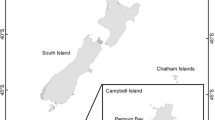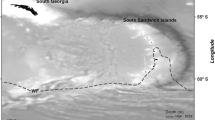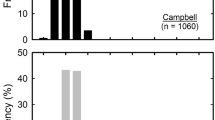Abstract
The food and feeding ecology of albatrosses during the nonbreeding season is still poorly known, particularly with regard to the cephalopod component. This was studied in black-browed Thalassarche melanophris and grey-headed T. chrysostoma albatrosses by analysing boluses collected shortly after adults returned to colonies at Bird Island, South Georgia (54°S, 38°W), in 2009. Based on stable isotopic analyses of the lower beaks, we determined the habitat and trophic level (from δ13C and δ15N, respectively) of the most important cephalopods and assessed the relative importance of scavenging in terms of the albatrosses’ feeding regimes. Based on lower rostral lengths (LRLs), the main cephalopod species in the diets of both albatrosses was Kondakovia longimana, by frequency of occurrence (F > 90 %), number (N > 40 %) and mass (M > 80 %). The large estimated mass of many squid, including K. longimana, suggests that a high proportion (>80 % by mass) was scavenged, and that scavenging is much more important during the nonbreeding season than would be expected from breeding-season diets. The diversity of cephalopods consumed by nonbreeding birds in our study was similar to that recorded during previous breeding seasons, but included two new species [Moroteuthis sp. B (Imber) and ?Mastigoteuthis A (Clarke)]. Based on similarities in LRL, δ13C and δ15N, the squid consumed may have been from the same oceanic populations or region, with the exception of Taonius sp. B (Voss) and K. longimana, which, based on significant differences in δ15N values, suggest that they may have originated from different stocks, indicating differences in the albatrosses’ feeding regimes.


Similar content being viewed by others
References
Arata J, Xavier JC (2003) The diet of black-browed albatrosses at the Diego Ramirez Islands, Chile. Polar Biol 26:638–647. doi:10.1007/s00300-003-0530-z
Arata J, Robertson G, Valencia J, Xavier JC, Moreno CA (2004) Diet of grey-headed albatrosses at the Diego Ramírez Islands, Chile: ecological implications. Antarct Sci 16:263–275. doi:10.1017/S095410200400207X
Arkhipkin AI, Laptikhovsky VV (2008) Discovery of the fourth species of the enigmatic chiroteuthid squid Asperoteuthis (Cephalopoda: Oegopsida) and extension of the range of the genus to the South Atlantic. J Molluscan Stud 74:203–207. doi:10.1093/mollus/eyn007
Brown CR, Klages NT (1987) Seasonal and annual variation in diets of Macaroni (Eudyptes chrysolophus chrysolophus) and Southern rockhopper (E. chrysocome chrysocome) penguins at sub-Antarctic Marion Island. J Zool 212:7–28. doi:10.1111/j.1469-7998.1987.tb05111.x
Cherel Y, Hobson KA (2005) Stable isotopes, beaks and predators: a new tool to study the trophic ecology of cephalopods, including giant and colossal squids. Proc R Soc Lond B Biol Sci 272:1601–1607. doi:10.1098/rspb.2005.3115
Cherel Y, Hobson KA (2007) Geographical variation in carbon stable isotope signatures of marine predators: a tool to investigate their foraging areas in the Southern Ocean. Mar Ecol Prog Ser 329:281–287. doi:10.3354/meps329281
Cherel Y, Klages N (1998) A review of the food of albatrosses. In: Robertson G, Gales R (eds) Albatross Biology and Conservation. Surrey Beatty & Sons, Chipping Norton, pp 113–136
Cherel Y, Weimerskirch H (1999) Spawning cycle of onychoteuthid squids in the southern Indian Ocean: new information from seabird predators. Mar Ecol Prog Ser 188:93–104. doi:10.3354/meps188093
Cherel Y, Hobson KA, Weimerskirch H (2000a) Using stable-isotope analysis of feathers to distinguish moulting and breeding origins of seabirds. Oecologia 122:155–162. doi:10.1007/pl00008843
Cherel Y, Weimerskirch H, Trouve C (2000b) Food and feeding ecology of the neritic-slope forager black-browed albatross and its relationships with commercial fisheries in Kerguelen waters. Mar Ecol Prog Ser 207:183–199. doi:10.3354/meps207183
Cherel Y, Weimerskirch H, Trouve C (2002) Dietary evidence for spatial foraging segregation in sympatric albatrosses (Diomedea spp.) rearing chicks at Iles Nuageuses, Kerguelen. Mar Biol 141:1117–1129. doi:10.1007/s00227-002-0907-5
Cherel Y, Duhamel G, Gasco N (2004) Cephalopod fauna of subantarctic islands: new information from predators. Mar Ecol Prog Ser 266:143–156. doi:10.3354/meps266143
Cherel Y, Gasco N, Duhamel G (2011) Top predators and stable isotopes document the cephalopod fauna and its trophic relationships in Kerguelen waters. In: Duhamel G, Welsford D (eds) The Kerguelen Plateau: marine ecosystem and fisheries, Proceedings of the 1st international Science Symposium on the Kerguelen Plateau. Société Française d’Ichtyologie, Abbeville, pp 99–108
Cherel Y, Jaeger A, Alderman R, Jaquemet S, Richard P, Wanless RM, Phillips RA, Thompson DR (2013) A comprehensive isotopic investigation of habitat preferences in nonbreeding albatrosses from the Southern Ocean. Ecography 36:277–286. doi:10.1111/j.1600-0587.2012.07466.x
Cherel Y, Jaquemet S, Maglio A, Jaeger A (2014) Differences in δ13C and δ15N values between feathers and blood of seabird chicks: implications for non-invasive isotopic investigations. Mar Biol 161:229–237. doi:10.1007/s00227-013-2314-5
Clarke MR (1986) A handbook for the identification of cephalopod beaks. Clarendon Press, Oxford
Collins MA, Rodhouse PG (2006) Southern Ocean Cephalopods. In: Alan J. Southward CMY, Lee AF (eds) Adv Mar Biol. Academic Press, pp 191–265
Connan M, McQuaid C, Bonnevie B, Smale M, Cherel Y, Klages N (2014) Combined stomach content, lipid and stable isotope analyses reveal spatial and trophic partitioning among three sympatric albatrosses from the Southern Ocean. Mar Ecol Prog Ser 497:259–272. doi:10.3354/meps10606
Croxall JP, Prince PA (1994) Dead or alive, night or day: how do albatrosses catch squid? Antarct Sci 6:155–162. doi:10.1017/S0954102094000246
Croxall JP, Prince PA (1996) Cephalopods as Prey. I. Seabirds. Philos Trans R Soc Lond Ser B Biol Sci 351:1023–1043. doi:10.1098/rstb.1996.0091
Croxall JP, Silk JR, Phillips RA, Afanasyev V, Briggs DR (2005) Global circumnavigations: tracking year-round ranges of nonbreeding albatrosses. Science 307:249–250. doi:10.1126/science.1106042
Furness BL, Laugksch RC, Duffy DC (1984) Cephalopod beaks and studies of seabird diets. Auk 101:619–620
González AF, Trathan PN, Yau C, Rodhouse PG (1997) Interactions between oceanography, ecology and fishery biology of the ommastrephid squid Martialia hyadesi in the South Atlantic. Mar Ecol Prog Ser 152:205–215. doi:10.3354/meps152205
Hobson KA, Cherel Y (2006) Isotopic reconstruction of marine food webs using cephalopod beaks: new insight from captively raised Sepia officinalis. Can J Zool 84:766–770. doi:10.1139/z06-049
Lu CC, Williams R (1994) Contribution to the biology of squid in the Prydz Bay region, Antarctica. Antarct Sci 6:223–229. doi:10.1017/S0954102094000349
Nel DC, Lutjeharms JRE, Pakhomov EA, Ansorge IJ, Ryan PG, Klages NTW (2001) Exploitation of mesoscale oceanographic features by grey-headed albatross Thalassarche chrysostoma in the southern Indian Ocean. Mar Ecol Prog Ser 217:15–26. doi:10.3354/meps217015
Phillips RA, Silk JR, Phalan B, Catry P, Croxall JP (2004) Seasonal sexual segregation in two Thalassarche albatross species: competitive exclusion, reproductive role specialization or foraging niche divergence? Proc R Soc Lond B Biol Sci 271:1283–1291. doi:10.1098/rspb.2004.2718
Phillips RA, Silk JRD, Croxall JP, Afanasyev V, Bennett VJ (2005) Summer distribution and migration of nonbreeding albatrosses: individual consistencies and implications for conservation. Ecology 86:2386–2396. doi:10.1890/04-1885
Phillips R, Bearhop S, McGill RR, Dawson D (2009) Stable isotopes reveal individual variation in migration strategies and habitat preferences in a suite of seabirds during the nonbreeding period. Oecologia 160:795–806. doi:10.1007/s00442-009-1342-9
Phillips R, McGill RR, Dawson D, Bearhop S (2011) Sexual segregation in distribution, diet and trophic level of seabirds: insights from stable isotope analysis. Mar Biol 158:2199–2208. doi:10.1007/s00227-011-1725-4
Piatkowski U, Pütz K, Heinemann H (2001) Cephalopod prey of king penguins (Aptenodytes patagonicus) breeding at Volunteer Beach, Falkland Islands, during austral winter 1996. Fish Res 52:79–90. doi:10.1016/S0165-7836(01)00232-6
Poncet S, Robertson G, Phillips RA, Lawton K, Phalan B, Trathan PN, Croxall JP (2006) Status and distribution of wandering, black-browed and grey-headed albatrosses breeding at South Georgia. Polar Biol 29:772–781. doi:10.1007/s00300-006-0114-9
Prince PA (1980) The food and feeding ecology of grey-headed albatross Diomedea chrysostoma and black-browed albatross D. melanophris. Ibis 122:476–488. doi:10.1111/j.1474-919X.1980.tb00902.x
Richoux N, Jaquemet S, Bonnevie B, Cherel Y, McQuaid C (2010) Trophic ecology of grey-headed albatrosses from Marion Island, Southern Ocean: insights from stomach contents and diet tracers. Mar Biol 157:1755–1766. doi:10.1007/s00227-010-1448-y
Rodhouse PG (1997) Precautionary measures for a new fishery on Martialia hyadesi (Cephalopoda, Ommastrephidae) in the Scotia Sea: an ecological approach. CCAMLR Sci 4:125–139
Rodhouse PG, Prince PA (1993) Cephalopod prey of the black-browed albatross Diomedea melanophrys at South Georgia. Polar Biol 13:373–376. doi:10.1007/bf01681978
Rodhouse PG, Yeatman J (1990) Redescription of Martialia hyadesi Rochebrune and Mabille, 1889 (Mollusca: Cephalopoda) from the Southern Ocean. Bull Br Mus Nat Hist (Zool) 56:135–143
Rodhouse PG, Prince PA, Clarke MR, Murray AWA (1990) Cephalopod prey of the grey-headed albatross Diomedea chrysostoma. Mar Biol 104:353–362. doi:10.1007/bf01314337
Schimmelmann A, DeNiro MJ (1988) Stable isotope studies on Chitin. II. The 13C/12C and 15N/14N ratios in arthropod chitin. Contrib Mar Sci 29:113–130
Stowasser G, Atkinson A, McGill RAR, Phillips RA, Collins MA, Pond DW (2012) Food web dynamics in the Scotia Sea in summer: a stable isotope study. Deep Sea Res Part 2 Top Stud Oceanogr 59–60:208–221. doi:10.1016/j.dsr2.2011.08.004
Waugh SM, Weimerskirch H, Cherel Y, Shankar U, Prince PA, Sagar PM (1999) Exploitation of the marine environment by two sympatric albatrosses in the Pacific Southern Ocean. Mar Ecol Prog Ser 177:243–254. doi:10.3354/meps177243
Wolf N, Carleton SA, Martínez del Rio C (2009) Ten years of experimental animal isotopic ecology. Funct Ecol 23:17–26. doi:10.1111/j.1365-2435.2009.01529.x
Xavier JC, Cherel Y (2009) Cephalopod beak guide for the Southern Ocean. British Antarctic Survey, Cambridge
Xavier JC, Croxall JP (2007) Predator-prey interactions: why do larger albatrosses eat bigger squid? J Zool 271:408–417. doi:10.1111/j.1469-7998.2006.00224.x
Xavier JC, Croxall JP, Reid K (2003a) Interannual variation in the diets of two albatross species breeding at South Georgia: implications for breeding performance. Ibis 145:593–610. doi:10.1046/j.1474-919X.2003.00196.x
Xavier JC, Croxall JP, Trathan PN, Rodhouse PG (2003b) Interannual variation in the cephalopod component of the diet of the wandering albatross, Diomedea exulans breeding at Bird Island, South Georgia. Mar Biol 142:611–622. doi:10.1007/s00227-002-0962-y
Xavier JC, Croxall JP, Trathan PN, Wood AG (2003c) Feeding strategies and diets of breeding grey-headed and wandering albatrosses at South Georgia. Mar Biol 143:221–232. doi:10.1007/s00227-003-1049-0
Xavier JC, Trathan PN, Croxall JP, Wood AG, Podestá G, Rodhouse PG (2004) Foraging ecology and interactions with fisheries of wandering albatrosses (Diomedea exulans) breeding at South Georgia. Fish Oceanogr 13:324–344. doi:10.1111/j.1365-2419.2004.00298.x
Xavier JC, Croxall JP, Cresswell KA, Burger AE (2005) Boluses: an effective method for assessing the proportions of cephalopods in the diet of albatrosses. The Auk 122:1182–1190. doi:10.1642/0004-8038(2005)122[1182:BAEMFA]2.0.CO;2
Xavier JC, Tarling GA, Croxall JP (2006) Determining prey distribution patterns from stomach-contents of satellite-tracked high-predators of the Southern Ocean. Ecography 29:260–272. doi:10.1111/j.2006.0906-7590.04525.x
Xavier JC, Phillips RA, Cherel Y (2011) Cephalopods in marine predator diet assessments: why identifying upper and lower beaks is important. ICES J Mar Sci 68:1857–1864. doi:10.1093/icesjms/fsr103
Xavier JC, Louzao M, Thorpe SE, Ward P, Hill C, Roberts D, Croxall JP, Phillips RA (2013) Seasonal changes in the diet and feeding behaviour of a top predator indicate a flexible response to deteriorating oceanographic conditions. Mar Biol 160:1597–1606. doi:10.1007/s00227-013-2212-x
Acknowledgments
We are grateful to Derren Fox, Stacey Adlard and Ewan Edwards at Bird Island research station for helping with sample collection in winter 2009, and Janet Silk for creating Fig. 1.This research was supported by the Ministry of Science and Higher Education, Portugal (Fundação para a Ciência e a Tecnologia), the British Antarctic Survey and the Tinker Foundation, under the research programs CEPH, SCAR AnT-ERA, PROPOLAR and ICED. This study represents a contribution to the Ecosystems component of the British Antarctic Survey Polar Science for Planet Earth Programme, funded by The Natural Environment Research Council.
Author information
Authors and Affiliations
Corresponding author
Rights and permissions
About this article
Cite this article
Alvito, P.M., Rosa, R., Phillips, R.A. et al. Cephalopods in the diet of nonbreeding black-browed and grey-headed albatrosses from South Georgia. Polar Biol 38, 631–641 (2015). https://doi.org/10.1007/s00300-014-1626-3
Received:
Revised:
Accepted:
Published:
Issue Date:
DOI: https://doi.org/10.1007/s00300-014-1626-3




